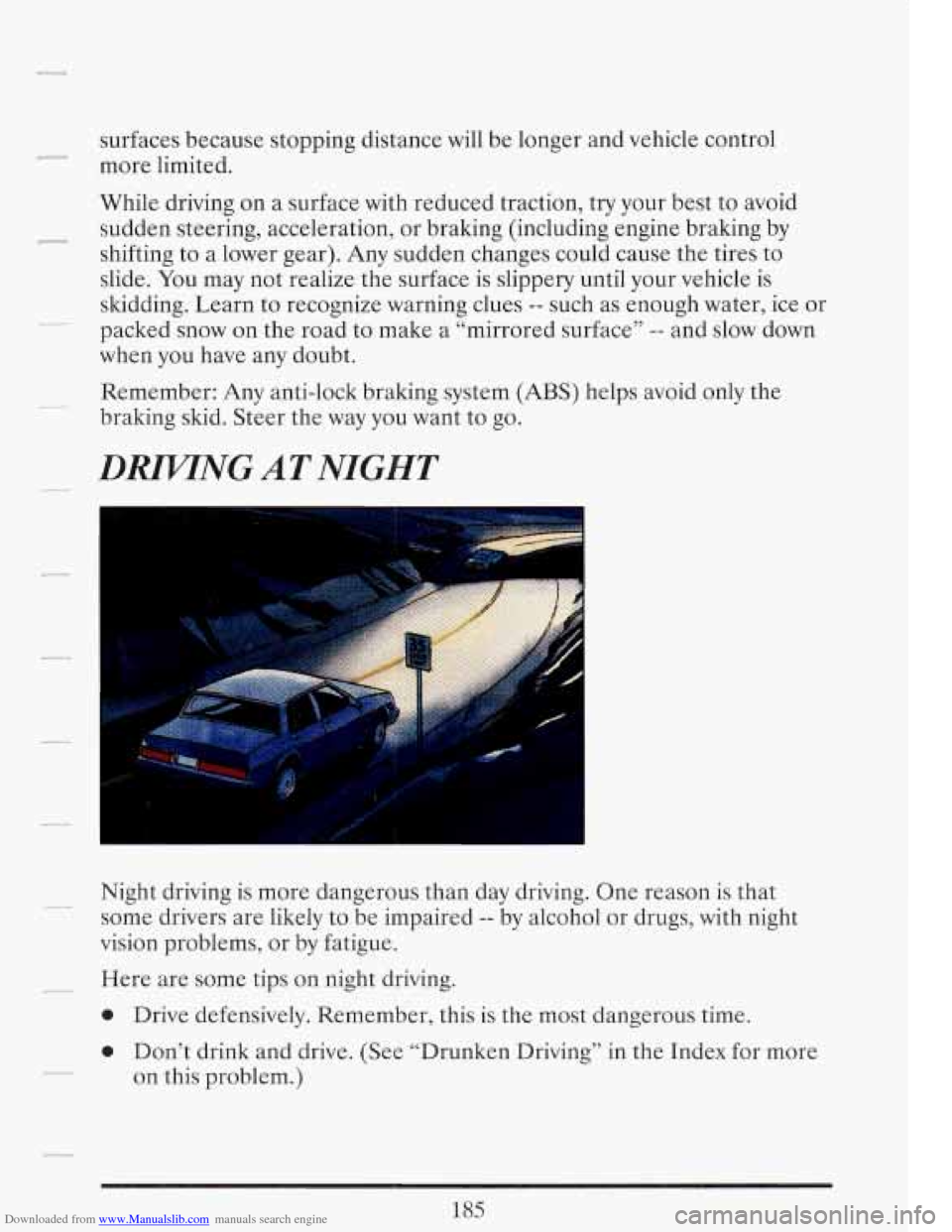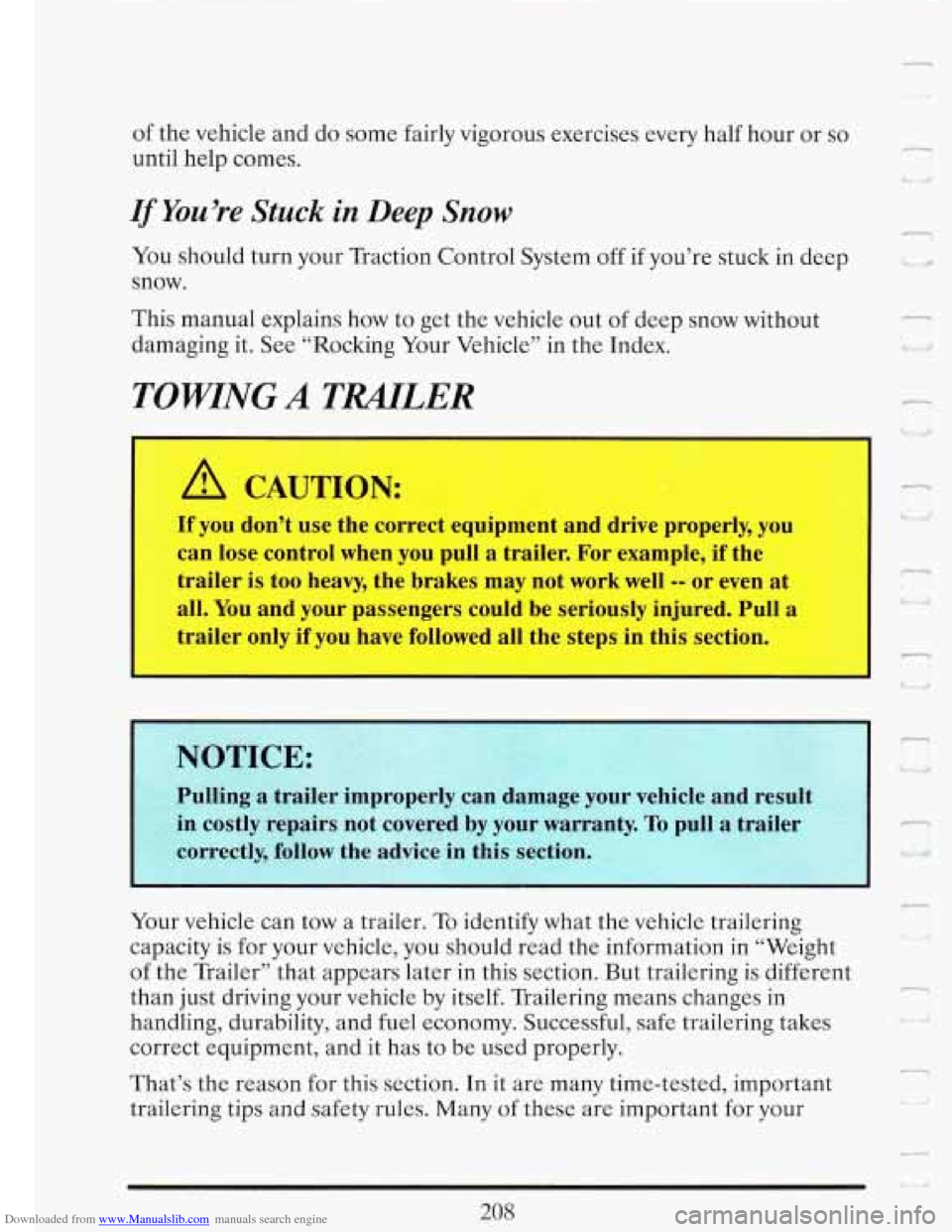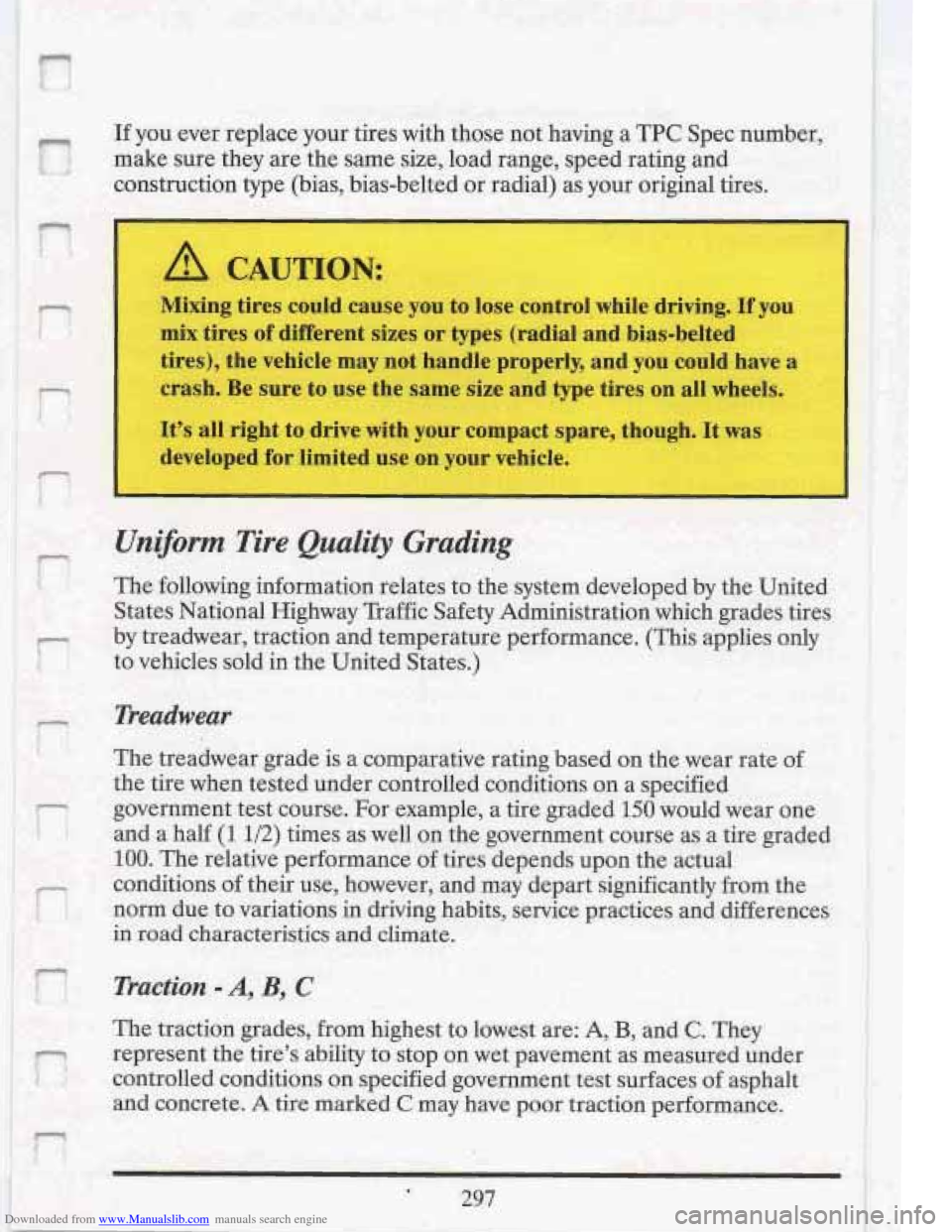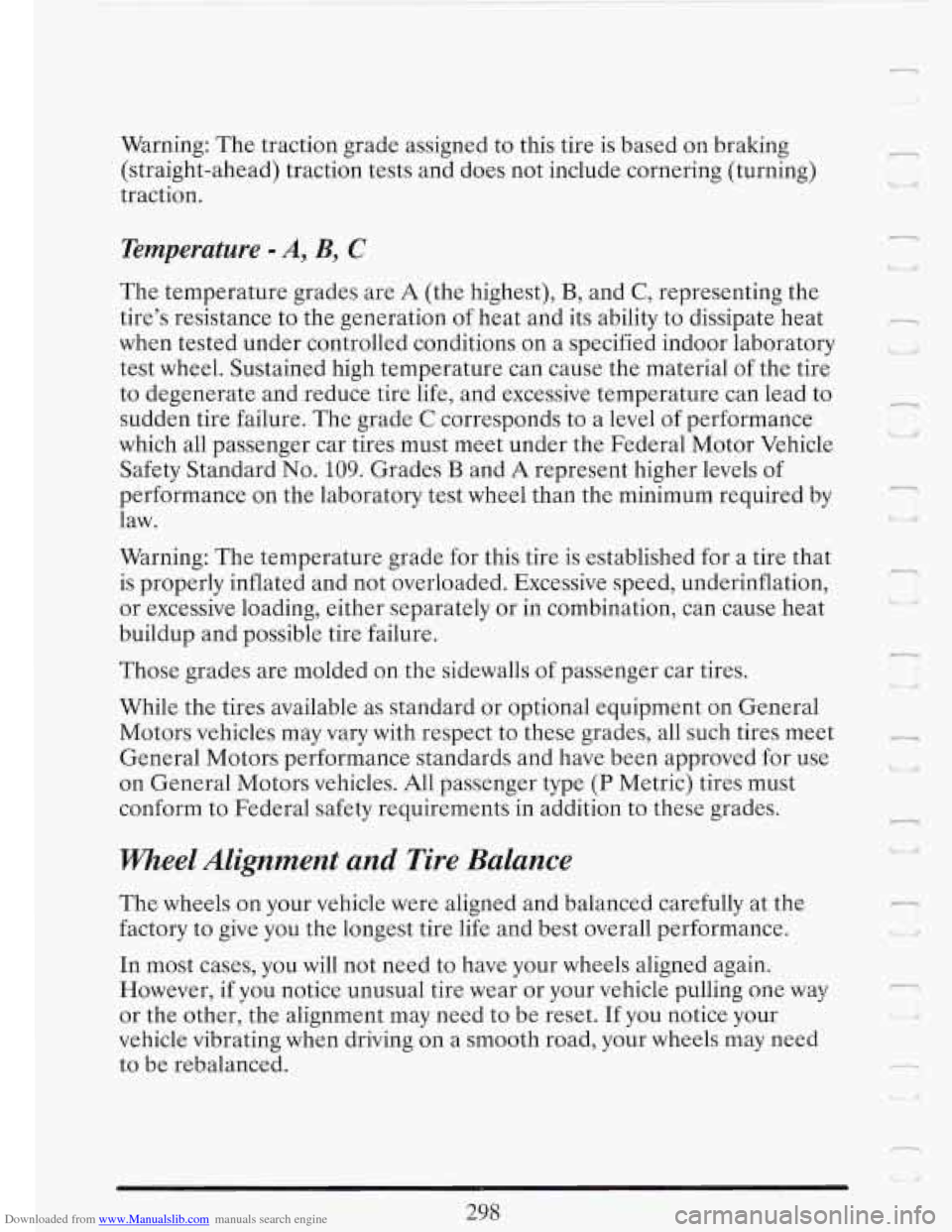1993 CADILLAC FLEETWOOD traction control
[x] Cancel search: traction controlPage 199 of 386

Downloaded from www.Manualslib.com manuals search engine surfaces because stopping distance will be longer and vehicle control
more limited.
While driving on a surface with reduced traction, try your best to avoid
sudden steering, acceleration, or braking (including engine braking by
shifting to a lower gear). Any sudden changes could cause the tires to
slide.
You may not realize the surface is slippery until your vehicle is
skidding. Learn to recognize warning clues
-- such as enough water, ice or
packed snow on the road to make a “mirrored surface”
-- and slow down
when you have any doubt.
Remember: Any anti-lock braking system
(ABS) helps avoid only the
braking skid. Steer the way you want to go.
DRMNG AT NIGHT
Night driving is more dangerous than day driving. One reason is that
some drivers are likely to be impaired
-- by alcohol or drugs, with night
vision problems, or by fatigue. --
I_ Here are some tips on night driving.
0 Drive defensively. Remember, this is the most dangerous time.
0 Don’t drink and drive. (See “Drunken Driving” in the Index for more
on this problem.)
Page 219 of 386

Downloaded from www.Manualslib.com manuals search engine I
- What’s the worst time for this? “Wet ice.” Very cold snow or ice can be
slick and hard to drive on. But wet ice can be even more trouble because
it may offer the least traction
of all. You can get “wet ice’’ when it’s about
freezing
(320F; OOC) and freezing rain begins to fall. Try to avoid driving
on wet ice until salt and sand crews can get there. -
Whatever the condition -- smooth ice, packed, blowing or loose snow --
- drive with caution. If your traction control system is disabled, accelerate
gently.
Try not to break the fragile traction. If you accelerate too fast
when your traction control system is disabled, the drive wheels will spin
and polish the surface under the tires even more.
Your traction control system improves your ability to accelerate
when
driving on a slippery road. Even though your vehicle has a traction
control system, you’ll want to slow down and adjust your driving to the
road conditions. See “Traction Control System” in the Index.
-
-
Your anti-lock brakes improve your ability to make a hard stop on a
want to begin stopping sooner than you would on dry pavement. See
“Anti-lock’’ in the Index.
7 slippery road. Even though you have the anti-lock braking system, you’ll
T Allow greater following distance on any slippery road.
e Watch for slippery spots. The road might be fine until you hit a spot
that’s covered with ice. On an otherwise clear road, ice patches may
Page 222 of 386

Downloaded from www.Manualslib.com manuals search engine of the vehicle and do some fairly vigorous exercises every half hour or so
until help comes.
If You’re Stuck in Deep Snow
You should turn your Traction Control System off if you’re stuck in deep
snow.
This manual explains how
to get the vehicle out of deep snow without
damaging it. See “Rocking Your Vehicle” in the Index.
TOWING A TMLER
A CAUTION:
If you don’t use the correct equipment and drive properly, you
can lose control when you pull a trailer. For example, if the
trailer is too heavy, the brakes may not work well
-- or even at
all.
You and your passengers could be seriously injured. Pull a
trailer only if you have followed all the steps in this section.
I
~~ ~ ~~ id
7
\. i
Pulling a trailer improperly can damage your vehicle and result
in costly repairs not covered by your warranty.
To pull a trailer -
c*
Your vehicle can tow a trailer. To identify what the vehicle trailering ;
capacity is for your vehicle, you should read the information in “Weight
of the Trailer” that appears later in this section. But trailering is different
than just driving your vehicle by itself. Trailering means changes in
handling, durability, and fuel economy. Successful, safe trailering takes
correct equipment, and it has to be used properly.
-
That’s the reason for this section. In it are many time-tested, important
trailering tips and safety rules. Many of these are important for your m .> d
c-
.J ~
208
Page 311 of 386

Downloaded from www.Manualslib.com manuals search engine i I
r I.
F 1.J
If you ever replace your tires with those not having a TPC Spec number,
make sure they are the same size, load range, speed rating and
construction type (bias, bias-belted or radial) as your original tires.
A CAUTION:
Mixing tires could cause you to lose control, while driving. If you
mix tires of different sizes or types (radial and bias-belted
tires), the vehicle may not handle properly, and you could have a
crash.
Be sure to use the same size and type tires on all wheels.
It's all right to drive with your compact spare, though. It was
developed for limited use
on your vehicle.
I
Ungorm Tire Quality Grading
The following information relates to the system developed by the United'
States National Highway Traffic Safety Administration which grades tires
I
by treadwear, traction and temperature performance. (This applies only
to vehicles sold in the United States.)
Treadwear
The treadwear grade is a comparative rating based on the wear rate of
the tire when tested under controlled conditions on a specified
government test course. For example, a tire graded
150 would wear one
and a half
(1 1/2) times as well on the government course as a tire graded
100. The relative performance of tires depends upon the actual
conditions
of their use, however, and may depart significantly from the
norm due to variations in driving habits, service practices and differences
in road characteristics and climate.
Traction -A, B, C !
-and concrete. A tire marked C may have poor traction performance. I I
The traction grades, from highest to lowest are: A, B, and C. They
represent the tire's ability to stop on wet pavement as measured under
controlled conditions on specified government test surfaces
of asphalt
Page 312 of 386

Downloaded from www.Manualslib.com manuals search engine 7
. .J
Warning: The traction grade assigned to this tire is based on braking
(straight-ahead) traction tests and does not include cornering (turning)
traction.
Temperature - A, B, C
The temperature grades are A (the highest), B, and C, representing the
tire's resistance to the generation of heat and its ability to dissipate heat
when tested under controlled conditions on a specified indoor laboratory
test wheel. Sustained high temperature can cause the material of the tire
to degenerate and reduce tire life, and excessive temperature can lead to
sudden tire failure. The grade
C corresponds to a level of performance
which all passenger car tires must meet under the Federal Motor Vehicle
Safety Standard
No. 109. Grades B and A represent higher levels of
performance on the laboratory test wheel than the minimum required by
law.
Warning: The temperature grade
for this tire is established for a tire that
is properly inflated and not overloaded. Excessive speed, underinflation,
or excessive loading, either separately or
in combination, can cause heat
buildup and possible tire failure.
Those grades are molded on the sidewalls of passenger car tires.
While the tires available as standard or optional equipment on General
Motors vehicles may vary with respect to these grades, all such tires meet
General Motors performance standards and have been approved for use
on General Motors vehicles.
All passenger type (P Metric) tires must
conform to Federal safety requirements in addition to these grades.
'Wheel Alignment and Tire Balance
The wheels on your vehicle were aligned and balanced carefully at the
factory to give you the longest tire life and best overall performance.
In most cases, you will not need
to have your wheels aligned again.
However,
if you notice unusual tire wear or your vehicle pulling one way
or the other, the alignment may need to be reset.
If you notice your
vehicle vibrating when driving
on a smooth road, your wheels may need
to be rebalanced.
3
I
c
UI
n
9
u
298
Page 375 of 386

Downloaded from www.Manualslib.com manuals search engine Light, Change Oil .................................. 131
Light, Charge
...................................... 130
Light, Coolant Temp
................................ 128
Light, Door Ajar ................................... 131
Light, Low Engine
Oil Level ......................... 130
Light, Pass Key Fault
................................ 135
Light, Safety Belt Reminder
......................... 12,19
Light, Service Engine
Soon .......................... 134
Light, Turn Signal Indicator
........................... 108
Light, Underhood
.................................. 1.11
Light, Washer Fluid Low ............................ 102
Lighter, Cigarette
.................................. 120
Lights
............................................ 108
Light, Cruise
Engaged
.............................. 133
Light,
Trunk Ajar ................................... 132
Lights, Operatian
Of ................................. 99
Lights, Reading
..................................... 112
Lights, Traction Control System
........................ 127
Lights, Warning, On Instrument Panel
................. 125
Lights, Traffic
...................................... 164
Limited-Slip Rear Axle
............................... 87
Loading Your Vehicle
............................... 290
Locking Fuel Filler Door ............................ 255
Log, Operating Record
.............. See Maint. Book, p.44
Long Distance Driving
.............................. 196
Loss Of Control .................................... 184
Low Battery, What To Do About A .................... 218
Low Coolant Warning Light .......................... 133
Low Oil Pressure, Warning Light For .................. 130
Low Windshield Washer Fluid, Warning Light For ....... 102
Lubricants, Recommended
........... See Maint. Book, p.38
Lumbar/Heater Seat ControIs
......................... 11
M
Manual, How To Use ................................. 1
Maintenance
A Word About
................... See Maint. Book, p.2
Coupons
......................... See Maint. Book, All
I3qlanation of Services .... See Maint. Book, p.18,20,22,24
Oil Change ...................... See Maint. Book, p.2
her Checks
............. See Mat. bok, p.26,28,30
Operating Record Log
.......... See Maint. Book, p.44-80
Recommended Fluids ....... See Maht. Book, p.38,40,42
Schedules
............... See Maint. Book, p.10,12,14,16
Service
Ctr. hspec. & Serv. .. See Maint. Book, p.32,34,36
Service Station Owner Checks
...... See Maint. Book, p.8
9
Page 381 of 386

Downloaded from www.Manualslib.com manuals search engine .
.
.
.
c
.
. .
r
.
Theft .............................................. 75
Theft Deterrent System (Option)
...................... 76
Thermostat
........................................ 272
Third Gear. When To Use
............................ 86
Tilt Steering Wheel
.................................. 95
Time. Setting The
.................................. 154
Tire Chains
........................................ 300
Tire. Flat
.......................................... 237
Tire Inflation
...................................... 293
Tire Inspection and Rotation
......................... 295
Tires
.. Loading .................................... 291
Tire Quality Grading
................................ 297
Tires
............................................. 292
Tires. When It’s Time For New Tires
.................. 296
Tires. White Sidewall. Cleaning
....................... 308
Tone Control. Automatic
............................ 147
Torn Safety Belts
.................................... 62
Torque Lock
....................................... 202
Towing A Trailer
................................... 208
Towing Your Cadillac
............................... 223
Traction Control Disable Switch
.................... 68. 177
Traction Control System Lights
....................... 127
Traction Control System
............................. 176
Trademarks. GM
................................... 251
Traffic Lights
...................................... 164
Traffic Officer
..................................... 166
Trailer Towing
..................................... 208
Trailer Towing Package
.............................. 118
Transmission. Automatic
............................. 83
Transmission Fluid
................................. 266
Transmission Gear Positions
.......................... 83
Travel. Brake Pedal
................................. 178
Trip Odometer ..................................... 124
Trunk Ajar Light
................................... 132
Trunk Release. Remote
.............................. 69
Turn Signal and Lane Change Indicator
................. 98
Turn Signalmeadlight Beam Lever .................... 100
Twilight Sentinel ................................... 110
Twisted Safety Belts .................................. 26
Two Children Wearing The Same Safety Belt
............. 59
Transmission Service
................ See Maint . Book. p.22
U
Underbody Maintenance ............................ 309
Underhood Light
................................... 111
Uniform Tire Quality Grading ........................ 297
Unleaded Gasoline
................................. 252
15